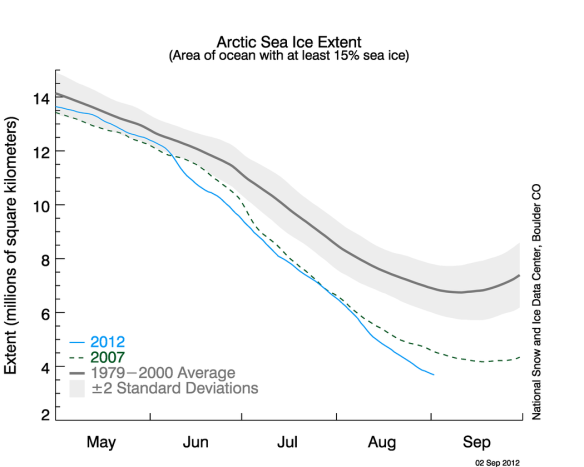This is what the last few days have taught me: even if the code for climate models can seem dense and confusing, the output is absolutely amazing.
Late yesterday I discovered a page of plots and animations from the Canadian Centre for Climate Modelling and Analysis. The most recent coupled global model represented on that page is CGCM3, so I looked at those animations. I noticed something very interesting: the North Atlantic, independent of the emissions scenario, was projected to cool slightly, while the world around it warmed up. Here is an example, from the A1B scenario. Don’t worry if the animation is already at the end, it will loop:

It turns out that this slight cooling is due to the North Atlantic circulation slowing down, as is very likely to happen from large additions of freshwater that change the salinity and density of the ocean (IPCC AR4 WG1, FAQ 10.2). This freshwater could come from either increased precipitation due to climate change, or meltwater from the Arctic ending up in the North Atlantic. Of course, we hear about this all the time – the unlikely prospect of the Gulf Stream completely shutting down and Europe going into an ice age, as displayed in The Day After Tomorrow – but, until now, I hadn’t realized that even a slight slowing of the circulation could cool the North Atlantic, while Europe remained unaffected.
Then, in chapter 8 of the IPCC, I read something that surprised me: climate models generate their own El Ninos and La Ninas. Scientists don’t understand quite what triggers the circulation patterns leading to these phenomena, so how can they be in the models? It turns out that the modellers don’t have to parameterize the ENSO cycles at all: they have done such a good job of reproducing global circulation from first principles that ENSO arises by itself, even though we don’t know why. How cool is that? (Thanks to Jim Prall and Things Break for their help with this puzzle.)
Jim Prall also pointed me to an HD animation of output from the UK-Japan Climate Collaboration. I can’t seem to embed the QuickTime movie (WordPress strips out some of the necessary HTML tags) so you will have to click on the link to watch it. It’s pretty long – almost 17 minutes – as it represents an entire year of the world’s climate system, in one-hour time steps. It shows 1978-79, starting from observational data, but from there it simulates its own circulation.
I am struck by the beauty of this output – the swirling cyclonic precipitation, the steady prevailing westerlies and trade winds, the subtropical high pressure belt clear from the relative absence of cloud cover in these regions. You can see storms sprinkling across the Amazon Basin, monsoons pounding South Asia, and sea ice at both poles advancing and retreating with the seasons. Scientists didn’t explicitly tell their models to do any of this. It all appeared from first principles.
Take 17 minutes out of your day to watch it – it’s an amazing stress reliever, sort of like meditation. Or maybe that’s just me…
One more quick observation: most of you are probably familiar with the naming conventions of IPCC reports. The First Assessment Report was FAR, the second was SAR, and so on, until the acronyms started to repeat themselves, so the Fourth Assessment Report was AR4. They’ll have to follow this alternate convention until the Eighth Annual Report, which will be EAR. Maybe they’ll stick with AR8, but that would be substantially less entertaining.


